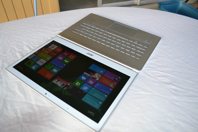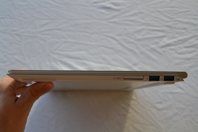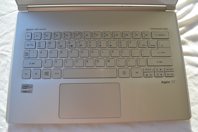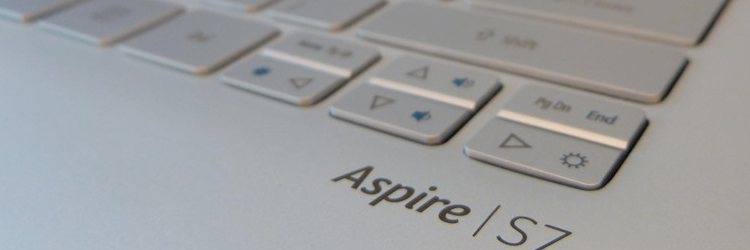Products cross my desk regularly. Some are great, some aren't, and most are in between. It's a perk, to be sure, but review products aren't often made for me. On a case-by-case basis, the products I'm looking are often aimed at different market segments than my own. That isn't the case with Acer's Aspire S7.
The touchable, classy ultrabook is targeted right at the road-warrior, power-hungry, super-user. The S7 is an expensive machine. The starting price hovers near $1400, but our Core i7 configured spec clocks in at $1650. For the price customers do see a superlative spec sheet and a beautifully designed body. I know what you're thinking. The S7 had better be amazing for that kind of money. Don't worry, with a few qualifiers, the Aspire S7 easily ranks among the top Windows 8 machines. Is that enough to justify the cost?

Hardware
Fashioned from aluminum and Gorilla Glass the S7's thin profile makes a great first impression. The deck and lid are completely rigid. There is zero flex in the laptops frame. It's very reassuring considering how light (2.29 lb) the machine is. The lid is framed with brushed aluminum that is soft and cool to the touch. That frame is filled with white glass that isn't nearly as fingerprint prone as I expected.
The same goes for the (more important) glass on the other side of the lid. I suspect that Acer applied an oleophobic coating to the glass surfaces on the machine. That oleophobic coating sparks a trend that follows through the construction of the rest of the laptop. On a laptop with a touchscreen, fingerprints are guaranteed to be a pain. That coating eases the user's pain, preventing all but the greasiest of fingers from greasing up the screen. Thoughtful design, and smart touches like these litter the Aspire S7.
Acer Aspire S7 - $1,650
- 13.3" 1920x1080 LED backlit multi-touch display
- Intel Core i7-3517U (1.9 - 3.0GHz)
- Intel HD Graphics 4000
- 4GB of DDR3 RAM
- 256GB SSD
- SD/MMC card reader
- 2 USB 3.0, HDMI, audio jack
- 802.11b/g/n, Bluetooth 4.0
- 1.3-megapixel webcam
- Chiclet keyboard
- Multi-gesture touchpad with integrated buttons
- 4-cell Li-Polymer battery (4680mAh)
- 12.73 x 8.79 x 0.47 inches, 2.86 pounds
Consider another constant problem with the first wave of touch-enabled laptops: The hinges simply aren't designed to stand up to poking and prodding. It leads to awkward ergonomic situations where the left hand is holding the screen in place while the right is slicing fruit in Fruit Ninja. Acer's machine corrects this error The hinge is remarkably stiff, and becomes even more stiff at the normal viewing angle. This addition makes the touchscreen function infinitely more comfortable and practical.
There's a trade-off there though, the strengthened hinge makes the S7 a bit more difficult to open than I'd like. To compensate, the entirety of the lid has a slight indentation on the rim. It's perfect for sliding a finger under, and while the laptop still isn't the easiest to open, smart design makes a distinct design trade-off less of a...well, trade-off.
The S7's cooling solution is another of my favorite design decisions. Every external fan is situated on the rear of the laptop. Because of this, the S7 will never blow hot air over your hands. It's smart, user-facing design.
These qualities, when combined with the S7's gorgeous frame make a compelling argument. Beyond that, the hardware design, even with a few small quibbles is the S7's best quality.
Hands-On
Actually using the S7 is more of a mixed bag. Some things, like the tiny power supply and charging port are great, other things, like the placement of the power button are not. The power button is on the left side of the deck and is very easily pressed. More than once, when moving the laptop while in-use (the power button is inactive while the lid is closed) my palm found the button and turned the machine off by accident. It seems that the power button moved as a concession to making a clean deck for the S7.
It wasn't a smart call, but that is the exception rather than the rule.




Moving to the deck, the keyboard is wonderful to touch. The keys are soft, responsive and have great travel, and not just for an ultrabook. There is a quirk to the keyboard. There's no function row. Instead, keys like the number row end up with triple functionality under Acer's five-row arrangement. It's not the biggest loss in the world, but keep in mind there will be a learning curve to the deeper functionality of the S7's keyboard.
The Elan manufactured trackpad is not very good. The one-button sheet of aluminum is, like the rest of the laptop, pleasing to the touch, but it simply doesn't work well for some tasks. Two-finger scrolling works extremely well in the Metro Start Screen, but can be jerky on web pages. Pinch-to-zoom is as wonky on Windows as it has ever been. Unfortunately, the Elan device stumbles on basic tasks as well. Finger tracking is solid, but tapping the pad to click works about 60% of the time, a tragically low proportion. Actually clicking the trackpad works, but this is hardly my first choice for interacting.


The touchscreen is superlative. It is responsive in every case and works exactly as you expect and want it to. Curiously, I found myself using it much more than I expected in the traditional desktop segments of Windows 8.
